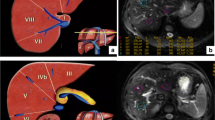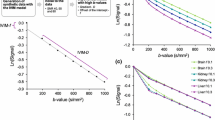Abstract
Objectives
To investigate the effect of b value and size of region of interest (ROI) on apparent diffusion coefficient (ADC) measurement and its reproducibility in liver diffusion-weighted imaging (DWI).
Methods
Thirty-six volunteers underwent liver DWI twice with b values of 0, 100, 500, and 800 s/mm2. ADCs were measured with ROI of 50 mm2 on ADC maps generated with different b values of (0, 100), (0, 500), (0, 800), (0, 100, 500), (0, 100, 800), (0, 500, 800), and (0, 100, 500, 800) s/mm2. ADCs from b values of (0, 800) s/mm2 were measured with 4 ROI sizes (50, 100, 200 and 300 mm2). ANOVA analysis was used to compare differences of ADCs among different ROI sizes and different combined b values. Bland–Altman method was used to assess reproducibility of ADC measurement.
Results
ADCs with larger ROI size were slightly higher than those with smaller one, while no statistical difference was found (P > 0.05). And reproducibility of ADC measurement with different ROI sizes was comparable (LOA 7.0–8.2% for right lobe, 14.15–17.4% for left lobe). ADCs statistically decreased with increased maximum b values (P < 0.05). ADC measurement achieved the best reproducible with maximum b value of 800 s/mm2 regardless of the number of b values.
Conclusions
The b values influence ADC measurement and its reproducibility, while the ROI sizes do not affect them. Two b values of (0, 800) s/mm2 and ROI of 50 mm2 are recommended for liver ADC measurement.



Similar content being viewed by others
Change history
09 July 2021
A Correction to this paper has been published: https://doi.org/10.1007/s42058-021-00071-5
References
Le Bihan D, Breton E, Lallemand D, et al. MR imaging of intravoxel incoherent motions: application to diffusion and perfusion in neurologic disorders. Radiology. 1986;161(2):401–7.
Zhou Y, Wang X, Xu C, et al. Mass-forming intrahepatic cholangiocarcinoma: can diffusion-weighted imaging predict microvascular invasion? J Magn Reson Imaging. 2019;50(1):315–24.
Rimola J, Forner A, Sapena V, et al. Performance of gadoxetic acid MRI and diffusion-weighted imaging for the diagnosis of early recurrence of hepatocellular carcinoma. Eur Radiol. 2019;30:186–94.
Jia Y, Cai H, Wang M, et al. Diffusion kurtosis MR imaging versus conventional diffusion-weighted imaging for distinguishing hepatocellular carcinoma from benign hepatic nodules. Contrast Media Mol Imaging. 2019;2019:2030147.
Shin MK, Song JS, Hwang SB, et al. Liver fibrosis assessment with diffusion-weighted imaging: value of liver apparent diffusion coefficient normalization using the spleen as a reference organ. Diagnostics. 2019;9(3):107.
Tang Z, Zhang XY, Liu Z, et al. Quantitative analysis of diffusion weighted imaging to predict pathological good response to neoadjuvant chemoradiation for locally advanced rectal cancer. Radiother Oncol. 2019;132:100–8.
Kim SY, Lee SS, Byun JH, et al. Malignant hepatic tumors: short-term reproducibility of apparent diffusion coefficients with breath-hold and respiratory-triggered diffusion-weighted MR imaging. Radiology. 2010;255(3):815–23.
Dale BM, Braithwaite AC, Boll DT, et al. Field strength and diffusion encoding technique affect the apparent diffusion coefficient measurements in diffusion-weighted imaging of the abdomen. Investig Radiol. 2010;45(2):104–8.
Kwee TC, Takahara T, Koh DM, et al. Comparison and reproducibility of ADC measurements in breathhold, respiratory triggered, and free-breathing diffusion-weighted MR imaging of the liver. J Magn Reson Imaging. 2008;28(5):1141–8.
Chen L, Shen F, Li Z, et al. Diffusion-weighted imaging of rectal cancer on repeatability and cancer characterization: an effect of b value distribution study. Cancer Imaging. 2018;18(1):43.
Gourtsoyianni S, Papanikolaou N, Yarmenitis S, et al. Respiratory gated diffusion-weighted imaging of the liver: value of apparent diffusion coefficient measurements in the differentiation between most commonly encountered benign and malignant focal liver lesions. Eur Radiol. 2008;18(3):486–92.
Parikh T, Drew SJ, Lee VS, et al. Focal liver lesion detection and characterization with diffusion-weighted MR imaging: comparison with standard breath-hold T2-weighted imaging. Radiology. 2008;246(3):812–22.
Kim SY, Lee SS, Park B, et al. Reproducibility of measurement of apparent diffusion coefficients of malignant hepatic tumors: effect of DWI techniques and calculation methods. J Magn Reson Imaging. 2012;36(5):1131–8.
Vaziri-Bozorg SM, Ghasemi-Esfe AR, Khalilzadeh O, et al. Diffusion-weighted magnetic resonance imaging for diagnosis of liver fibrosis and inflammation in chronic viral hepatitis: the performance of low or high b values and small or large regions of interest. Can Assoc Radiol J. 2012;63(4):304–11.
Bilgili MY. Reproductibility of apparent diffusion coefficients measurements in diffusion-weighted MRI of the abdomen with different b values. Eur J Radiol. 2012;81(9):2066–8.
Corona-Villalobos CP, Pan L, Halappa VG, et al. Agreement and reproducibility of apparent diffusion coefficient measurements of dual-b-value and multi-b-value diffusion-weighted magnetic resonance imaging at 1.5 tesla in phantom and in soft tissues of the abdomen. J Comput Assist Tomogr. 2013;37(1):46–51.
Larsen NE, Haack S, Larsen LP, et al. Quantitative liver ADC measurements using diffusion-weighted MRI at 3 tesla: evaluation of reproducibility and perfusion dependence using different techniques for respiratory compensation. MAGMA. 2013;26:431–42.
Erturk SM, Ichikawa T, Sano K, et al. Diffusion-weighted magnetic resonance imaging for characterization of focal liver masses: impact of parallel imaging (sense) and b value. J Comput Assist Tomogr. 2008;32(6):865–71.
Lewin M, Poujol-Robert A, Boelle PY, et al. Diffusion-weighted magnetic resonance imaging for the assessment of fibrosis in chronic hepatitis c. Hepatology. 2007;46(3):658–65.
Taouli B, Chouli M, Martin AJ, et al. Chronic hepatitis: role of diffusion-weighted imaging and diffusion tensor imaging for the diagnosis of liver fibrosis and inflammation. J Magn Reson Imaging. 2008;28(1):89–95.
Colagrande S, Pasquinelli F, Mazzoni LN, et al. MR-diffusion weighted imaging of healthy liver parenchyma: repeatability and reproducibility of apparent diffusion coefficient measurement. J Magn Reson Imaging. 2010;31(4):912–20.
Taouli B, Koh DM. Diffusion-weighted MR imaging of the liver. Radiology. 2010;254(1):47–66.
Shrout PE, Fleiss JL. Intraclass correlations: uses in assessing rater reliability. Psychol Bull. 1979;86(2):420–8.
Busing KA, Kilian AK, Schaible T, et al. Reliability and validity of MR image lung volume measurement in fetuses with congenital diaphragmatic hernia and in vitro lung models. Radiology. 2008;246(2):553–61.
Bland JM, Altman DG. Statistical methods for assessing agreement between two methods of clinical measurement. Lancet. 1986;1(8476):307–10.
Filipe JP, Curvo-Semedo L, Casalta-Lopes J, et al. Diffusion-weighted imaging of the liver: usefulness of ADC values in the differential diagnosis of focal lesions and effect of ROI methods on ADC measurements. Magma. 2013;26(3):303–12.
Bruegel M, Holzapfel K, Gaa J, et al. Characterization of focal liver lesions by ADC measurements using a respiratory triggered diffusion-weighted single-shot echo-planar MR imaging technique. Eur Radiol. 2008;18(3):477–85.
Chen X, Qin L, Pan D, et al. Liver diffusion-weighted MR imaging: reproducibility comparison of ADC measurements obtained with multiple breath-hold, free-breathing, respiratory-triggered, and navigator-triggered techniques. Radiology. 2014;271(1):113–25.
Murtz P, Flacke S, Traber F, et al. Abdomen: diffusion-weighted MR imaging with pulse-triggered single-shot sequences. Radiology. 2002;224(1):258–64.
Andreou A, Koh DM, Collins DJ, et al. Measurement reproducibility of perfusion fraction and pseudodiffusion coefficient derived by intravoxel incoherent motion diffusion-weighted MR imaging in normal liver and metastases. Eur Radiol. 2013;23(2):428–34.
Wan Q, Deng YS, Lei Q, et al. Differentiating between malignant and benign solid solitary pulmonary lesions: are intravoxel incoherent motion and diffusion kurtosis imaging superior to conventional diffusion-weighted imaging? Eur Radiol. 2019;29(3):1607–15.
Author information
Authors and Affiliations
Corresponding author
Additional information
Publisher's Note
Springer Nature remains neutral with regard to jurisdictional claims in published maps and institutional affiliations.
The original online version of this article was revised.
Rights and permissions
About this article
Cite this article
Huang, Y., Xie, L., Cao, Z. et al. Effect of b values and size of region of interest on apparent diffusion coefficient measurement and its reproducibility in liver diffusion-weighted MRI. Chin J Acad Radiol 4, 56–62 (2021). https://doi.org/10.1007/s42058-021-00053-7
Received:
Revised:
Accepted:
Published:
Issue Date:
DOI: https://doi.org/10.1007/s42058-021-00053-7




